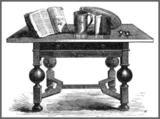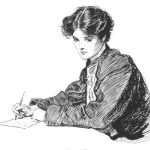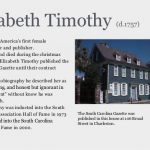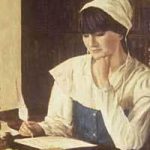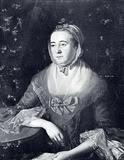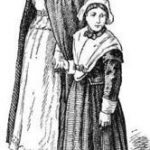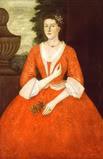First Woman Editor-Publisher in America
Elizabeth Timothy ( or Timothee) is recognized as America’s first female newspaper editor and publisher, and one of the world’s first female journalists. She performed these roles with distinction, especially considering her other responsibilities as mother, homemaker and widow.
Louis Timothy and his family were among a group of French Huguenot immigrants from Rotterdam who arrived in Philadelphia aboard the ship Britannia of London in 1731. Named on the ship’s roster were Louis and four Timothy children: Peter, Louis, Charles, and Mary, ranging in age from 1 to 6. Although Elizabeth Timothy’s name was not on the roster, she undoubtedly accompanied the family.
The Timothy family settled in Philadelphia, and Louis, a master of the French language, advertised his services as a tutor of French in Benjamin Franklin‘s Pennsylvania Gazette. At the time, Franklin was entertaining the idea of establishing a foreign-language newspaper for the increasing German population around Philadelphia and persuaded Louis to become the first editor of the Philadelphische Zeitung.
Issues appeared on May 6, 1732, and on June 24, 1732, but none thereafter. Timothy next became librarian of another of Franklin’s projects, the Philadelphia Library Company, and a journeyman printer at Franklin’s Pennsylvania Gazette.
Franklin encouraged competent printers for his Gazette to become publishers and printers in other colonies. One was Thomas Whitmarsh, who was sent to Charles Town (later Charleston) to establish the South Carolina Gazette. Not long after the paper began publication, Whitmarsh died of yellow fever, and Louis Timothy was persuaded to take his place.
Franklin and Timothy entered into a six-year business agreement whereby Franklin furnished the press and other equipment, paid one-third of the expenses, and was to receive a third of the profits from the enterprise.
Timothy revived the South Carolina Gazette in 1733. The following year, his wife and children joined him in Charles Town, where they became members of St. Philip’s Anglican Church. Timothy also helped organize a subscription postal system originating at his printing office and, in 1736, obtained a land grant of 600 acres and a town lot in Charles Town.
When Louis Timothy died during the Christmas season of 1738, a year remained on his contract with Franklin, which provided for Timothy’s eldest son, Peter, to carry on the business until the contract expired.
Louis had anticipated the likelihood of his own demise because three previous South Carolina printers had died of fever soon after arriving in the colony. He had put in a special clause in the Franklin partnership contract that his eldest son Peter could succeed him if he prematurely died, but Peter was just thirteen years old when Louis died.
Peter was training as an apprentice with his father, but was too inexperienced to take over the business. Franklin agreed to take on Elizabeth Timothy as a partner until Peter was capable of running the shop. When Elizabeth became Franklin’s partner she had six children.
Elizabeth assumed control of the printing operation and published the next weekly issue of the South Carolina Gazette on January 4, 1739, which carried the announcement that she was editing the paper. This established her as America’s first woman editor-publisher. The publisher, however – which must be a male – was listed as Peter Timothy.
Elizabeth informed her readers that it was customary in a printer’s family in the colonies and in Europe for a wife and sons to help with the printing operation. She asked them “to continue their Favors and good Offices to this poor afflicted Widow and six small children and another hourly expected.”
Her first newspapers carried little local news, and the quality of the literary content also suffered at first. The Gazette relied more heavily than ever before on foreign and domestic news exchanges. Elizabeth herself often wrote homilies – inspirational pieces – and carried essays that emulated those in English journals.
She reprinted dramas, poetry, and literary classics, as well as printing the first efforts of new Southern writers. The Gazette remained four pages, approximately 8 by 13 inches in size, and type was at first set in two columns, later in three.
Elizabeth Timothy, official printer of the colony, printed acts and other proceedings for the Assembly. As the first woman in America to own and publish a newspaper, she played a vital role in the development of Charles Town and South Carolina, and published the Gazette for seven years. During her tenure the newspaper was not “political” and did not offend the authorities.
In addition to the Gazette, she printed books, pamphlets, tracts, and other publications. The inscription “Peter Timothy” appeared after each, but Elizabeth no doubt made most of the decisions in the operation of the business.
The printing process in those days was extremely labor-intensive. Type was set by hand, a letter at a time, in a hand-held composing stick. The type was locked into a form, or chase, and placed on the press. The type was inked before each impression, and printed one sheet at a time on a century-old press.
As the wife of a wealthy and influential publisher, Elizabeth Timothy enjoyed a social position attained by only a few women printers of the colonial period. But the success of the newspaper and printing business after Louis Timothy’s death can only be attributed to Elizabeth Timothy’s business acumen and management skills.
Years later, in his autobiography, Benjamin Franklin described Louis Timothy as “a man of learning, and honest but ignorant in matters of account; and tho’ he sometimes made me remittances, I could get no account from him, nor any satisfactory state of our partnership while he lived.” But Franklin had only praise for Elizabeth Timothy.
Franklin attributed her ability in this field to her having been “born and bred in Holland, where, as I have been informed, the knowledge of accounts makes a part of female education.” Franklin also said that the widow managed the business with “such success that she not only brought up reputably a family of children but at the expiration of the term was able to purchase of me the printing house and establish her son in it.”
When Peter Timothy turned 21 in 1746, he assumed operation of the Gazette. Elizabeth opened a book and stationery store next door to the printing office on King Street. In a Gazette ad published in October 1746, Elizabeth announced the availability of books such as pocket Bibles, spellers, primers, and books titled Reflections on Courtship and Marriage, Armstrong’s Poem on Health, The Westminster Confession of Faith, and Watts’ Psalms and Hymns.
She also offered bills of lading, mortgages, bills of sale, writs, ink powder, and quills — all very cheap. She operated her shop for about a year, but during that time she advertised in the Gazette that she planned to leave the province, and asked that anyone who owed money to her or to her husband’s estate to settle their debts within three months.
It is unclear when Elizabeth left Charles Town or where she made her new home. But by 1756, she had returned to Charles Town, and on April 2, 1757, she wrote her will and died within a month. She left substantial assets that reflected her shrewd business ability.
Elizabeth Timothy was inducted into the South Carolina Press Association Hall of Fame in 1973. A plaque recognizing her unique role in South Carolina business and journalism occupies a spot “on the bay near Vendue Range,” where she last served as publisher of the South-Carolina Gazette. She was inducted into the South Carolina Business Hall of Fame in 2000.
SOURCES
Louis Timothee
Up From the Footnote: A History of Women Journalists
